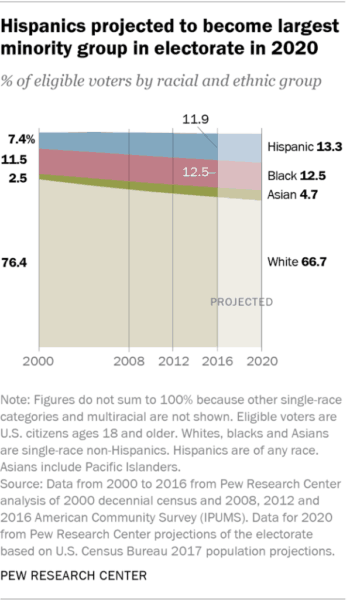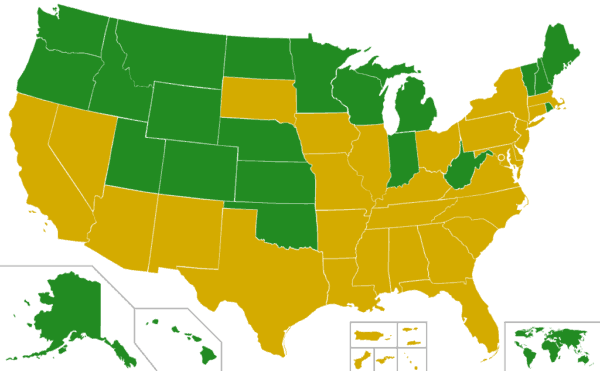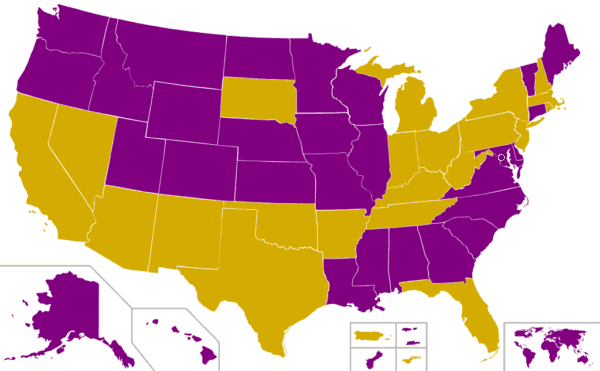Can Hispanics Put Bernie Over the Top?
Chris Roberts, American Renaissance, February 1, 2020

Sen. Bernie Sanders receives endorsement from Alexandria Ocasio-Cortez at Bernie Sanders Rally In Queensbridge Park on October 19, 2019 in New York City. (Credit Image: © Kristin Callahan / Ace Pictures via ZUMA Press)
Hispanics are the largest non-white group in America, and their numbers are steadily growing, but their political impact lags behind their numbers. Hispanics surpassed blacks in numbers two decades ago, but only this year are they projected to be the largest non-white voting bloc, at 13.3 percent — small, compared to their 18.3 percent share of the population.

As this chart shows, for blacks and whites, their shares of the population and the electorate are essentially the same. There are too few Asians to be very consequential for now, especially since they are largely clustered in the single-party states of the Pacific Coast.
Although Hispanics are concentrated in the Southwest, there are still many of the throughout the country, excluding parts of the West and the Deep South. They are also rapidly closing the gap between their share of the population and their share of the electorate. In 2000, Hispanics were 12.5 percent of the population, and only 7.4 percent of the electorate. A generation later and that gap has shrunk dramatically.
Since Hispanics vote Democrat about 75 percent of the time, their share of the Democrat electorate is around 23 percent — just short of the black share, which sits at 25 percent. In theory, then, if one candidate for the Democrat presidential nomination had the always monolithic black vote tied up, another candidate could counter that almost entirely by winning the Hispanic vote.
This could be crucial in 2020, because the current race appears to be coming down to Joe Biden — who dominates the black vote — and Bernie Sanders — whose campaign is working hard to win Hispanics. Will this strategy pay off? Can Sen. Sanders ride a brown wave to the nomination?
Probably not. In 2016, Sen. Sanders did so poorly with Hispanic voters that even substantial gains with them will not be enough to make up for the black vote he is sure to lose by enormous margins. Here is a map of the 2016 Democrat primary contest by state — Mr. Sanders’ victories are in green, and Mrs. Clinton’s are in yellow:

Credit: Wikimedia
That year, there were 11 states that were 15 percent or more Hispanic. Mr. Sanders won only one of them: Colorado.
Over the last few months, Mr. Sanders has won increasing Hispanic support, but the bar was set so low in 2016 that the gains will not make much difference. This recent poll broke out Hispanic support nationally as follows:
| Candidate | Percentage of Hispanic Support |
| Bernie Sanders | 33 |
| Joe Biden | 23 |
| Elizabeth Warren | 11 |
| Andrew Yang | 8 |
| Michael Bloomberg | 8 |
| Pete Buttigieg | 5 |
| Tom Steyer | 3 |
Other polls in early-voting states since November show similar results. A recent Fox News poll of caucusgoers in Nevada — the first heavily Hispanic state to vote — found that “the top picks among Hispanics are Sanders (31 percent) and Biden (24 percent), with Warren a distant third (10 percent).” Seven percent is a decent lead over Mr. Biden, but is not enough to win the state: “Biden receives the backing of 24 percent of Democratic caucusgoers, followed by Sanders and Elizabeth Warren each at 18 percent.”
If Mr. Sanders wants to compensate for the black vote with the Hispanic vote, he will need a lot more than one third of it. Moreover, as the race progresses, the number of candidates will thin, and this will benefit Mr. Biden more than Mr. Sanders. If, by the time Nevada votes, Mr. Biden and Mr. Sanders could be the only candidates left. They might split the Hispanic support for Elizabeth Warren and Andrew Yang evenly, but Hispanics who back Michael Bloomberg, Pete Buttigieg, Tom Steyer, and Amy Klobuchar are more likely to swing to Mr. Biden. These last four are relative moderates, and it’s hard to see their supporters going for Mr. Sanders. If I’m right, the Hispanic vote would look like this:
| Candidate | Percentage of Hispanic Support |
| Joe Biden | 48.5 |
| Bernie Sanders | 42.5 |
For about 25 years, demographers, activists, and pundits have tried to guess when the Hispanic giant will finally flex its electoral muscles. Given their current share of the electorate, and their poor turnout rates, 2020 does not look like the year it will happen. Those most bullish about Mr. Sanders’ Hispanic support are predicting he will win Texas and California on March 3 ( “Super Tuesday”), thus making him a serious contender. Those pushing this theory should remember that in 2008, Hispanics preferred Hillary Clinton over Barack Obama by nearly two to one, which played a huge role in her winning the delegate-rich states of not only California and Texas, but Florida as well. Here is a map of the 2008 nomination fight. Sates Mr. Obama won are purple; states Mrs. Clinton won are yellow.

Credit: Wikimedia
But that wasn’t enough for her to win the nomination. Moreover, the Hispanics in Florida are much more conservative than Hispanics elsewhere — making them more likely to support Mrs. Clinton than Mr. Sanders. At the same time, today — just as in 2016 — the elite and donor class of the Democrat Party despise Mr. Sanders, and will do all they can to block his nomination. Carrying a third or even half of Hispanic voters will not be enough to override the wishes of insiders and billionaires.
There will come a day when Hispanics can tip the scales of virtually any American election. Blessedly, that day is yet to come.















